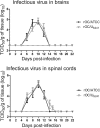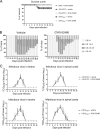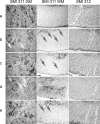Glutamate excitotoxicity is involved in the induction of paralysis in mice after infection by a human coronavirus with a single point mutation in its spike protein
- PMID: 21957311
- PMCID: PMC3209392
- DOI: 10.1128/JVI.05576-11
Glutamate excitotoxicity is involved in the induction of paralysis in mice after infection by a human coronavirus with a single point mutation in its spike protein
Abstract
Human coronaviruses (HCoV) are recognized respiratory pathogens, and some strains, including HCoV-OC43, can infect human neuronal and glial cells of the central nervous system (CNS) and activate neuroinflammatory mechanisms. Moreover, HCoV-OC43 is neuroinvasive, neurotropic, and neurovirulent in susceptible mice, where it induces chronic encephalitis. Herein, we show that a single point mutation in the viral spike (S) glycoprotein (Y241H), acquired during viral persistence in human neural cells, led to a hind-limb paralytic disease in infected mice. Inhibition of glutamate excitotoxicity using a 2-amino-3-(5-methyl-3-oxo-1,2-oxazol-4-yl)propranoic acid (AMPA) receptor antagonist (GYKI-52466) improved clinical scores related to the paralysis and motor disabilities in S mutant virus-infected mice, as well as protected the CNS from neuronal dysfunctions, as illustrated by restoration of the phosphorylation state of neurofilaments. Expression of the glial glutamate transporter GLT-1, responsible for glutamate homeostasis, was downregulated following infection, and GYKI-52466 also significantly restored its steady-state expression level. Finally, GYKI-52466 treatment of S mutant virus-infected mice led to reduced microglial activation, which may lead to improvement in the regulation of CNS glutamate homeostasis. Taken together, our results strongly suggest an involvement of excitotoxicity in the paralysis-associated neuropathology induced by an HCoV-OC43 mutant which harbors a single point mutation in its spike protein that is acquired upon persistent virus infection.
Figures






References
-
- Anderson C. M., Swanson R. A. 2000. Astrocyte glutamate transport: review of properties, regulation, and physiological functions. Glia 32:1–14 - PubMed
Publication types
MeSH terms
Substances
Grants and funding
LinkOut - more resources
Full Text Sources
Medical

